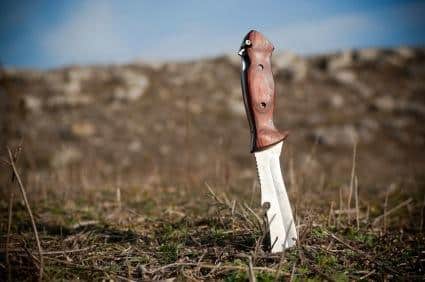 You’re just an average Joe –or Josephine. You didn’t grow up around hunting, trapping, or survival skills. While you might have dozed off to a fishing show once or twice on a Saturday, you’ve only been fishing a handful of times. You live in the Great Civilization of Suburbia, driving a Hyundai Accent to the office and back, five days a week, only to blankly watch cliché cop-show reruns through dinner until bed.
You’re just an average Joe –or Josephine. You didn’t grow up around hunting, trapping, or survival skills. While you might have dozed off to a fishing show once or twice on a Saturday, you’ve only been fishing a handful of times. You live in the Great Civilization of Suburbia, driving a Hyundai Accent to the office and back, five days a week, only to blankly watch cliché cop-show reruns through dinner until bed.
You’ve never been so bored in your entire life.
Of course, when shows like Survivorman come on the TV, your mind begins to wander. “Why couldn’t I do things like that?” you ask. Believe it or not, though you may live in a development of cookie-cutter duplexes, you can still find yourself in the woods, living off nature’s good bounty.
Now, you must keep in mind, this is more than just a hobby. If you don’t take the time to learn, learn, and then learn some more, you might find yourself in a real bind. However, if you are studious, cautious, and highly adventurous, then being a self-made suburbanite woodsman is in your reach. Before you know it, you will have the skills to live in concrete jungle and the great outdoors.
What Is Bushcraft?
Wikipedia’s definition of the term “bushcraft” is as follows: “Bushcraft is a long-term extension of survival skills.” In other words, learning bushcraft has less to do with “survival” and more to do with thriving in the woods.
Bushcraft goes beyond survival, and begins to look at the woods as more of a second home. Sure, the idea behind Surivorman is that you’re doing everything you can to just get back to civilization. With bushcraft, you’re purposely trying to leave civilization behind you.
If you’ve seen any good YouTube video concerning survival supplies, they all advocate having a “72-hour pack.” It is true that you should certainly have acquired a pack like this (taking an inventory about once a month). Your survival kit should contain supplies for you to sustain yourself for three days; your bushcraft kit should contain supplies for you to sustain yourself for about three weeks or more.
The common misconception is that a bushcraft kit needs to be an absolutely massive hunk of stuff that you sling over your shoulder and huff and puff the entire way into the middle of nowhere, only to get there and wish you were back on the couch. Actually, your bushcraft kit doesn’t need to be very big at all. The difference between the two packs is the possession of knowledge.
Ultra Efficient Water Filter Fits In Your Pocket!
In addition to that, just because you’re in need of tools that will hold up to the rigors of the wild doesn’t mean you have to blow the budget. In fact, you should be able to find most of the supplies you need at a dollar store, hardware store, or military surplus store. You might be surprised just how little you might have to spend.
There is a very simple principle embedded in bushcraft survival skills:
The more you know, the less you will have to carry.
Nature is bursting at the seams with survival supplies. Any herbalist worth his or her salt could walk into your front yard and find no less than three edible plants. You can use sticks and stones as tools, you can use pine resin for glue, and you don’t even need a high-powered bolt-action rifle at a buck per round to hunt game.
Of course, if you have good tools for the tasks at hand, that will make your life much, much easier. Also, there are certain items that are very difficult to duplicate in the wild, which means that you should keep them in your pack.
The purpose of this series is to give you an idea about which supplies you should keep in your pack, where to get them, and how to modify them to your needs. The majority will consist of supplies and modifications that are going to run you less than $20.
If You Don’t Enjoy Yourself …Then Stop!
If you aren’t enjoying yourself in the wild, then simply don’t do it. Bushcraft should be enjoyed and experienced. Finding yourself in the middle of the woods, roasting a squirrel over a spit, boiling water to make it drinkable, or constantly bending over to read rabbit tracks isn’t for everyone.
You must approach this subject with an open mind and an excitement to learn, as that could mean the difference between living… and being miserable (or worse).
The City Slicker’s Guide to Bushcraft On a Budget is a series of articles that should get you started in the right direction to becoming an accomplished woodsman. This information is, by no means, exhaustive; however, if it puts your mind at ease knowing that you can actually live without money or the things society deems to be a necessity (like condos, cars, and credit cards), then we’ve done our job.
This isn’t a survival article series. This is a series on how to have the time of your life, needing nothing more than your pack, your wits, and Mother Nature. That is one of the most empowering feelings you may ever experience.
Rationale
By reading these articles, we merely want to point you in the right direction in terms of the items you should acquire, while you are still in civilization and you still have access to the local hardware store. We aren’t going to cover many methods in this series; however, we will be going over the most important tools you can accumulate to make your life easy in the wild. Basically, we are going to show you that you don’t have to invest thousands when a few bucks here and there will do just fine. Check back here next Friday for our next installment!
©2013 Off the Grid News











